ST MARY MAGDALEN, ILLUMINATED BY BALDASSARE COLDIRADI, a cutting of a historiated initial from a choirbook, in Latin, illuminated manuscript on vellum[Italy (Cremona), late 15th century (c. 1480s)]
a cutting, c. 60 × 80mm, trimmed to the edges of the decoration, perhaps from the antiphon ‘Mulier quae erat in civitate peccatrix’ for the feast of Mary Magdalen (22 July), the reverse with a fragment of the continuation of this chant (‘[cepit rig]are pe[des eius]’) with music in square notation on red staves; the historiated initial ‘M’ depicting the saint half-length, in profile (reminiscent of contemporary northern Italian medals and portraits on panel), with long golden hair, holding a gold ointment-jar; reported in 2013 to be inscribed on the reverse in pencil ‘from the Cathedral of Como’, no longer present (on such inscriptions, incorrect but common on cuttings from the Ottley collection, see Melograni, 1994, p. 293 and n. 71); slight imperfections at the outer extremities, including a crease in the lower right corner only affecting a foliate bud, but generally in very fine condition with rich colours and sparkling gold; in a modern giltwood frame.
PROVENANCE? THE AUGUSTINIAN NUNNERY OF SANTA MONICA, CREMONA (Palladino, 2003, p. 132).? LUIGI CELOTTI (1759–1843), Venetian abbot and art dealer (on whom see Eze, 2016): doubtless sold or traded to:WILLIAM YOUNG OTTLEY (1771–1836): sold in our rooms, 11 May 1838, lot 142, bought for £1 by ‘Northwick’:JOHN RUSHOUT, LORD NORTHWICK (1770–1859): sold as part of ‘The Magnificent Series of Illuminated Miniatures and Initials, the Property of the Late John, Lord Northwick’ in our rooms, 16 November 1925, part of lot 106 (mis-identified as St Barbara), bought by Maggs; presumably bought from them by:COELLA LINDSAY RICKETTS (1859–1941), of Chicago (de Ricci, 1937); a large part, but not all, of whose collection was acquired in 1961 by the Lilly Library, Bloomington.Friedrich Georg Zeileis (b. 1939): included in successive editions of his catalogue (2001–2009) before being deaccessioned.Sold at Christie’s, 12 June 2013, lot 16 (lot 14 and 15 were cuttings from the same manuscript, one of which is now at the Louvre, Paris); bought by:The Boehlen Collection, Bern, MS 1428.
ILLUMINATIONThis sparkling initial is one of a large group of cuttings securely attributed to Baldassare Coldiradi, who was paid for the illumination of choir books for Cremona cathedral in 1482–84, although he was doubtless there before and after this narrow span of years (Passoni, 2004). It is one of a sizable group of cuttings, several of which share an early 19th-century provenance, and doubtless come from the same volume (or set of volumes), probably cut up in the late 18th century. The cuttings were grouped together by Anna Melograni (1995, pp. 20–22): three are in Philadelphia (Free Library, Lewis E M 71:1a-c), one is at Oberlin, Ohio (Allen Memorial Art Museum, 1943.17), and the present initial is one of three that belonged successively to Ottley, Northwick, Ricketts, and Zeileis, before being separated in 2013. Another very closely-related group is in an album of cuttings in Oxford (Bodleian Library, MS. Douce d. 13, fols. 11, 16, 19–22); the likelihood is that these too reached England via Celotti or Ottley. Palladino makes a persuasive case that Coldiradi was associated, together with the illuminator Frate Nebridio, with the convent of Sant’Agostino, Cremona, and that the cuttings come from the female Augustinian house in the city: Santa Monica.
REFERENCESS. de Ricci, Census of Medieval and Renaissance Manuscripts in the United States and Canada, I (New York, 1935), p. 632 no. 100.
A. Melograni, ‘Miniature inedite del Quattrocento lombardo nelle collezione americane’, Storia dell’Arte, 82 (1994), pp. 283–302.
A. Melograni, ‘Miniature inedite del Quattrocento lombardo nelle collezione americane [seconda parte]’, Storia dell’Arte, 83 (1995), pp. 5–27.
Friedrich Georg Zeileis, “Più ridon le carte”: Buchmalerei aus Mittelalter und Renaissance: Katalog einer Privatsammlung (Gallspach, 2001), no. 109; (2nd. edn., 2004 ), no. 111; (3rd edn., 2007 and 2009), no. 117.
M.C. Passoni, in Dizionario biografico dei miniatori italiani: secoli IX–XVI, ed. by M. Bollati (Milan, 2004), pp. 167–71
A.-M. Eze, ‘Abbé Luigi Celotti and the Sistine Chapel manuscripts’, Rivista di storia della miniatura, 20 (2016), pp. 139–54.
ST MARY MAGDALEN, ILLUMINATED BY BALDASSARE COLDIRADI, a cutting of a historiated initial from a choirbook, in Latin, illuminated manuscript on vellum[Italy (Cremona), late 15th century (c. 1480s)]
a cutting, c. 60 × 80mm, trimmed to the edges of the decoration, perhaps from the antiphon ‘Mulier quae erat in civitate peccatrix’ for the feast of Mary Magdalen (22 July), the reverse with a fragment of the continuation of this chant (‘[cepit rig]are pe[des eius]’) with music in square notation on red staves; the historiated initial ‘M’ depicting the saint half-length, in profile (reminiscent of contemporary northern Italian medals and portraits on panel), with long golden hair, holding a gold ointment-jar; reported in 2013 to be inscribed on the reverse in pencil ‘from the Cathedral of Como’, no longer present (on such inscriptions, incorrect but common on cuttings from the Ottley collection, see Melograni, 1994, p. 293 and n. 71); slight imperfections at the outer extremities, including a crease in the lower right corner only affecting a foliate bud, but generally in very fine condition with rich colours and sparkling gold; in a modern giltwood frame.
PROVENANCE? THE AUGUSTINIAN NUNNERY OF SANTA MONICA, CREMONA (Palladino, 2003, p. 132).? LUIGI CELOTTI (1759–1843), Venetian abbot and art dealer (on whom see Eze, 2016): doubtless sold or traded to:WILLIAM YOUNG OTTLEY (1771–1836): sold in our rooms, 11 May 1838, lot 142, bought for £1 by ‘Northwick’:JOHN RUSHOUT, LORD NORTHWICK (1770–1859): sold as part of ‘The Magnificent Series of Illuminated Miniatures and Initials, the Property of the Late John, Lord Northwick’ in our rooms, 16 November 1925, part of lot 106 (mis-identified as St Barbara), bought by Maggs; presumably bought from them by:COELLA LINDSAY RICKETTS (1859–1941), of Chicago (de Ricci, 1937); a large part, but not all, of whose collection was acquired in 1961 by the Lilly Library, Bloomington.Friedrich Georg Zeileis (b. 1939): included in successive editions of his catalogue (2001–2009) before being deaccessioned.Sold at Christie’s, 12 June 2013, lot 16 (lot 14 and 15 were cuttings from the same manuscript, one of which is now at the Louvre, Paris); bought by:The Boehlen Collection, Bern, MS 1428.
ILLUMINATIONThis sparkling initial is one of a large group of cuttings securely attributed to Baldassare Coldiradi, who was paid for the illumination of choir books for Cremona cathedral in 1482–84, although he was doubtless there before and after this narrow span of years (Passoni, 2004). It is one of a sizable group of cuttings, several of which share an early 19th-century provenance, and doubtless come from the same volume (or set of volumes), probably cut up in the late 18th century. The cuttings were grouped together by Anna Melograni (1995, pp. 20–22): three are in Philadelphia (Free Library, Lewis E M 71:1a-c), one is at Oberlin, Ohio (Allen Memorial Art Museum, 1943.17), and the present initial is one of three that belonged successively to Ottley, Northwick, Ricketts, and Zeileis, before being separated in 2013. Another very closely-related group is in an album of cuttings in Oxford (Bodleian Library, MS. Douce d. 13, fols. 11, 16, 19–22); the likelihood is that these too reached England via Celotti or Ottley. Palladino makes a persuasive case that Coldiradi was associated, together with the illuminator Frate Nebridio, with the convent of Sant’Agostino, Cremona, and that the cuttings come from the female Augustinian house in the city: Santa Monica.
REFERENCESS. de Ricci, Census of Medieval and Renaissance Manuscripts in the United States and Canada, I (New York, 1935), p. 632 no. 100.
A. Melograni, ‘Miniature inedite del Quattrocento lombardo nelle collezione americane’, Storia dell’Arte, 82 (1994), pp. 283–302.
A. Melograni, ‘Miniature inedite del Quattrocento lombardo nelle collezione americane [seconda parte]’, Storia dell’Arte, 83 (1995), pp. 5–27.
Friedrich Georg Zeileis, “Più ridon le carte”: Buchmalerei aus Mittelalter und Renaissance: Katalog einer Privatsammlung (Gallspach, 2001), no. 109; (2nd. edn., 2004 ), no. 111; (3rd edn., 2007 and 2009), no. 117.
M.C. Passoni, in Dizionario biografico dei miniatori italiani: secoli IX–XVI, ed. by M. Bollati (Milan, 2004), pp. 167–71
A.-M. Eze, ‘Abbé Luigi Celotti and the Sistine Chapel manuscripts’, Rivista di storia della miniatura, 20 (2016), pp. 139–54.



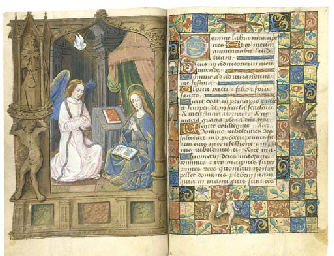
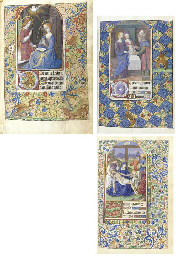
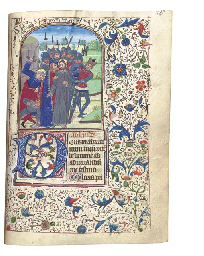




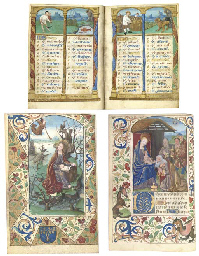
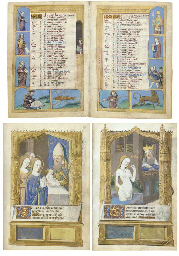



Testen Sie LotSearch und seine Premium-Features 7 Tage - ohne Kosten!
Lassen Sie sich automatisch über neue Objekte in kommenden Auktionen benachrichtigen.
Suchauftrag anlegen